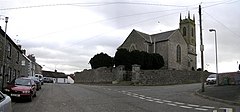Tynan
Tynan
| |
|---|---|
 | |
Location within Northern Ireland | |
| Population | 71 (2011 Census) |
| District | |
| County | |
| Country | Northern Ireland |
| Sovereign state | United Kingdom |
| Postcode district | BT60 |
| Dialling code | 028 |
| UK Parliament | |
| NI Assembly | |
Tynan (from Irish Tuíneán, meaning "watercourse"[1]) is a village, townland (of 375 acres) and civil parish in County Armagh, Northern Ireland. It is situated largely in the historic barony of Tiranny, with some areas in the barony of Armagh,[2] around 11 kilometres (7 mi) west of Armagh City.
Tynan had a population of 71 people (35 households) in the 2011 Census.[3] (2001 Census: 71 people)
History[edit]
Tynan won the status as the most well-preserved rural Irish village in 1993. [citation needed]
The Troubles[edit]
On January 21, 1981, Sir Norman Stronge, 8th Baronet (86), Ulster Unionist Party member, and former Speaker at Stormont, and his son, James Stronge (48), an off-duty member of the Royal Ulster Constabulary reserve, were shot dead by the Provisional Irish Republican Army (IRA) at their mansion, Tynan Abbey, Tynan.[4]
Places of interest[edit]
Tynan Abbey has an extensive demesne, a country house belonging to the Stronge family was situated here until it was destroyed by the Provisional IRA in 1981.[5][6] The ruins have since been demolished. The grounds hold an extensive cemetery with grave stones going back centuries and others worn beyond recognition.
Tynan has a High cross in the village's church yard, dating from 700 to 900.[citation needed] It shows a carving of Adam and Eve under an apple tree.

Transport[edit]
The Ulster Railway opened the station on 25 May 1858 as Tynan, Caledon & Midleton.[7] In 1876 the Ulster Railway merged with other railways to become the Great Northern Railway (Ireland).
Tynan was formerly served by mainline trains of the Great Northern Railway (Ireland) and was also the eastern terminus of the narrow gauge Clogher Valley Railway. Tynan railway station on the Clogher Valley railway opened on 2 May 1887 and shut 1 January 1942. Tynan and Caledon railway station on the mainline opened on 25 May 1858 and shut on 1 October 1957.[8]
People[edit]
- Peter McManus, recipient of the Victoria Cross.[citation needed]
- The antiquarian William Reeves was the Church of Ireland Rector of Tynan in the 1860s.[9]
Civil parish of Tynan[edit]
The civil parish contains the villages of Killylea, Middletown and Tynan.[2]
See also[edit]
References[edit]
- ^ PlaceNamesNI - Tynan Archived 17 July 2011 at the Wayback Machine
- ^ a b "Tynan". IreAtlas Townlands Database. Retrieved 6 May 2015.
- ^ "Tynan". Census 2011 Results. NI Statistics and Research Agency. Retrieved 30 April 2015.
- ^ NI Conflict Archive on the Internet
- ^ 'The Green Book: I' from 'The IRA' by Tim Pat Coogan (1993)
- ^ Biographies of Members of the Northern Ireland House of Commons, election.demon.co.uk; accessed 17 October 2015.
- ^ "Tynan & Caledon" (PDF). Railscot - Irish Railways. Retrieved 29 April 2012.
- ^ "Tynan and Tynan and Caledon stations" (PDF). Railscot - Irish Railways. Retrieved 24 November 2007.
- ^ Crockford's Clerical Directory (Church of England Church Commissioners, 1868), p. 771


